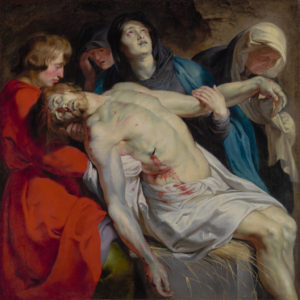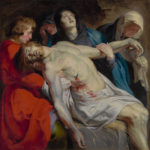The Entombment
Peter Paul Rubens, The Entombment, c. 1612 (oil on canvas, 131.1 x 130.2 cm)
In The Entombment (c. 1612), the oil painting by the sixteenth-century Flemish artist Peter Paul Rubens, our gaze is immediately drawn by the pitch-dark depths of the open fold that serves both as the source of blood that pours down from the side of the body of Jesus, and as the focal point of the image. The reason why our eye is immediately detained by this pulsating black hole is the very nature of its execration: a vivid and intense red hue that conveys richness as much as sheerness; fluidity as much as dryness, like wet tempera paint recently applied to the absorbing surface of wood. According to an anecdote told by the art historian Gustav Friedrich Waagen, when Guido Reni saw a painting by Rubens for the first time, his bewilderment by the Flemish artist’s brushstroke was such, that he could help but to exclaim: ‘Does this painter mix blood with his colours?’ The fluidity of the precious liquid, and Rubens’ skill as painter of the living flesh, make it possible to trace the path followed by both blood and paint. The vital fluid streams down, and runs freely in between the folds of skin that normally cover the inner canals of the body (veins and arteries, blood and spirit). Finally, it stains the fold of the white linen that gently wraps the lower part of his body, leaving a multiple mark: blood on skin, blood on shroud, oil on canvas. As the blood flows along these infinite folds and canals, our eyes follow these trajectories, replicating their movement. It is as aif, when put in direct contact, the image pierced our eyes, which suddenly start to shed tears of the blood it stares at, as it simultaneously paints it, becoming a skill hand. In return, the open wound on the painting becomes a crying eye itself. We find ourselves trapped in an exchange of gazes (Christ’s open wound and our very own eyes), touches (the image that pierces our eyes, and our eyes that paint the image), and fluids (blood and paint): a mystical communion between subject and painting that goes beyond vision, an ecstatic kiss.
Suddenly, the painting ceases to be an image, and becomes an invitation to touch. As we continue to follow the path marked by these infinite folds (paraphrasing Deleuze’s words on Baroque art), we stumble upon a hand that is both veiny and transparent, opaque and reflecting. This hand, unlike the rest of the limbs and the body of Jesus, falls freely at the bottom of the picture, not held nor supported by any other figure.
First, we find the figure of Joseph of Arimathea, dressed in red and standing by the left side of the picture. The owner of the tomb mediates his touch with a piece of white linen, like the strips that cover the body of the Christ. Impregnated with a blend of myrrh and spices, this shroud becomes the signature perfume of the tension and the union between life and death, between flesh and spirit that Jesus himself impersonates: the mystery of incarnation and the triumph of the senses. And then we find the figure of the virgin Mary, dressed in blue and with a livid countenance, except only for her eyes turned red from crying. She holds Jesus’ left arm directly with her left hand, and the back of his head, as she looks up. Finally, Mary of Clopas bends down and leans closer to Jesus’ left hand, which she does not touch directly either. Her posture suggests close visual examination of Jesus’ wounds from the cross, or perhaps it is another kind of sensory evaluation? Maybe she inspires the scent of the corpse preserved in the scented concoction of eternal life? Or perhaps it is not assessment that she seeks, but the adoration of the sacred nature of the wound, or of Christ’s whole body. Perhaps she is just about to kiss the wound, and to taste its sweetness, or perhaps she just did. Blood and the sacred, just as tears and the materials used to paint them, do not only have a particular colour and tactile properties, but they also possess a distinctive taste. The hand that falls freely is place as a visual-tactile invitation to consumption. It is up to the viewer to either look closer, touch (directly or not), smell, and finally, accept the offer of eternal life made by the painted body of Christ. Originally designed as the central piece of an altarpiece on Christ’s descent from the Cross, that is, to be positioned in the place of the celebration of the Eucharist, suddenly, The Entombment becomes an image of taste.
Those who contemplate Rubens’ mixture of oil and tears, of blood and red chalk, shall take Jesus’ falling hand, and drink from an ever-pouring jug of wine, an infinite source of eternal life. Those who see shall have the sweet taste of the divine, and nourish the mouth of their spirits: O taste and ye shall see.
Further reading:
Frank R. Ankersmit, Sublime Historical Experience, Stanford University Press, 2005.
Ann W. Astell, Eating Beauty: The Eucharist and the Spiritual Arts of the Middle Ages, Cornell University Press, 2006.
Gilles Deleuze, The Fold: Leibniz and the Baroque, translated by Tom Conley, Continuum, 2006.
Norman E. Land, ‘Blood as Paint: Rubens, Guido Reni, and Parrhasius,’ Notes in the History of Art 31, 2 (Winter 2012), 22-23.
Laura Eliza Enriquez
Concordia University, Montreal, Quebec, Canada


